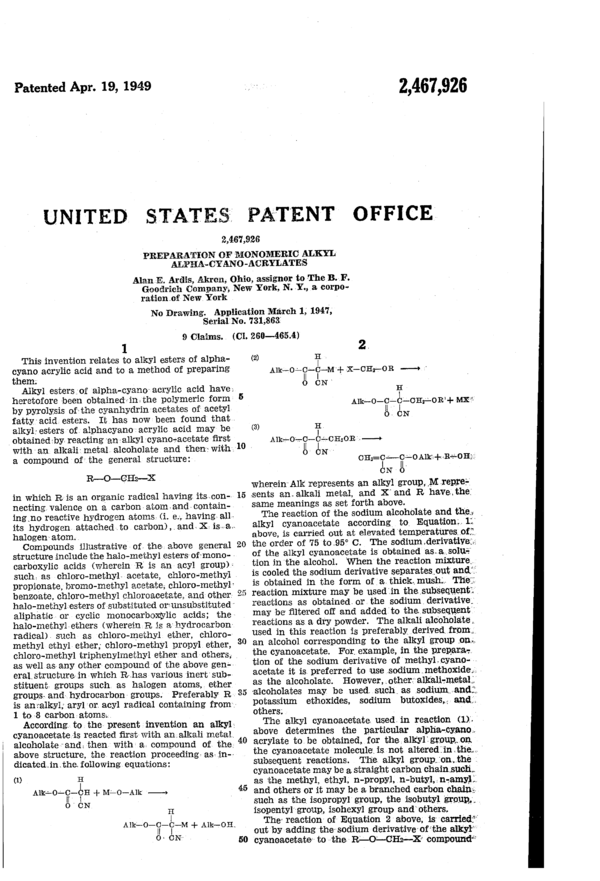PREPARATION OF MONOMERIC ALKYL
Year:
Type of document:
Language:
Patented Apr. 19, 1949
UNITED
2,467,926
S;TA.TE.;S‘j PATENT OFFICE).
2,467,926
PREPARATION OF MONOMERIC ALKYL
ALPI-IA- CYANO —ACRYLATES
A1an.E. Ardis, Akron, Ohio, assignor to The B. F.
Goodrich Company, New York, N. .Y., a corpo-
ration of New York
No Drawing. Application March 1, 1947,‘
Serial‘No. 731,863‘
9 Claims.
I
This invention relates to alkyl esters of alpha-
cyano acrylic acid and to a method of preparing
them.
Alkyl esters ;of alpha-cyano acrylic acid h9«Ve':
heretofore -been ob»tained»in=the polymeric form
by pyrolysis of-the cyanhydrinracetates of’ acetyl
fattyiacidi esters. It has now been found that
alkyl: esters of. alphacyanoacrylic acid may be
obtained :by reacting an I alkyl -cyanoeacetate first
with-an.a1kali'meta1.a1coho1ate and thenwwith.
a compound of’ the general structure:
R——O——CH2—X
in which Rt‘ is an organic radical having. its..con-,
nectingvalence on a carbon.atom.and.contain-
ing.no reactive hydrogen atoms: (1. e.‘, havingall
its hydrogen attached-. to carbon),.and-X: iS"‘«‘al1‘
halogen- atom. .
Compounds illustrative » of. the. above general
structure include the halo-methyl esters- of -mono-
carboxylic acids (wherein R is an- acyl group):
such. as chloro—methy-1- acetate, chloro-methyl .
propi-onate, bromo-methyl acetate, chloro-methyl‘
benzoate, chloro-methyl chloroacetate, and other
halo-Vmethylsesters of substituted orfunsubstituted ‘
aliphatic or cyclic monocarboxgylic acids; the
halo-methylethers (Wherein.R, is ahydrocarbon»
radical) such as chloro-methyl ether, chloro-~
methyl ethyl ether; chloro-methyl propyl ether,
chloro-methyl triphenylmethyl ether andvothers,»
as well as- any other compoundof the above gen‘-
eral_ structure in-which Ruhas vario.us inertsube»
stituent. groups such as halogen atoms, ether
groups» and hydrocarbon groups.’ Preferably R
is an -:alkyl; ar»y1’or. acyl radical containing from
1 tov»8 carbon-atoms-...
According. tothe present invention an alkyl
cyanoacetate -is reacted firstwith analkali metal.
a1co.holate"and; then with; a; compound of the,-
above structure, the reaction proceeding asuin-»
dicatedin .the.. following equations:
(1) H
I
A‘1k'—‘—0—-(!'T‘—(EH + M'—O——A]k ‘-——>
O ' CN
H
I
Alk——-0—C—C——M + Alk—OH..
I I
o CN“
«10 ,
15
20
NJ
in
30
35
40
45
50
(Cl. 260—465.4)
2.
(2) Fl! ~
AIk——0'—(|'|)—-(|J—M'+ X—CH2—OR ——-) '
0 ON‘ H
Alk-—O—?—(]2'—O‘EI7—‘-OR‘+ MK???
6. in
(3) H.
A1k+O—.C——-+‘—.CH20’R ' u —->
to cN
CH2=Cé——C—0Alk‘=+. »R—“.‘—OH‘;r.
éN m'a'i-n -fraction *dis£ti1:ling "over -at -150 to
17'il°- ‘was. ~colleet.ed ‘a receiver immersed in
liquid nitrogen. The boiling rpoint ~'ran=ge~'of 4:50
to '1!70.r° C. is not a true boiling point because a
higher temperature. is: necessary to vdepolymerize
the ester. The resulting monomeric. 'eth.yl~‘a~l.°pha-
cyano acrylate polymerized easily when warmed
to .50?’ ‘C. ‘or higher.
The monomeric ethyl alpha-cyano =ac‘r;yla;te
prepared in =Exampl'e= i had a ‘freezing point or
—20 to 4-25“ G. -and '-upon "analysis was found to
contain 11.21% nitrogen, 57.40% carbon, and
5.64% hydrogen ‘(theoretical for ethyl alpha-
cyano acrylate is 11.20% nitrogen, 57.59% car-
bon and 5.64% 5h.y'd»roge‘n=)-. "The hard polymer
prepared frorn. the monomer --had a softening
point or 1iob'c., a'm’e‘1ting p‘o"int.oIf .150 to 160° C.
and was soluble in acetone but insoluble in alco-
hol and ether.
It was -fz0U.!.’1d that a considerable portion of -the
dis-t_illa‘t’e in -the distillation -of Example I stuck
to ‘thewalls. of-.. the distilling side arm and -in the
ad'a"pterfand..»it. was found that this material had
polymerized. .-It was -further -found that if a
stream ‘of nitric oxide gas was introduced to the
distillation ‘flask just above the surface of the
distilland the polymerization of the distillate in
the side arm and receiver was eliminated and
the ester obtained in the monomeric form.
Example I I
Methyl alpha-cyano acrylate was prepared by
a procedure similar to that of Example I using
23 grams of metallic sodium and 500 ml. of abso-
lute methanol in the preparation of the sodium
alcoholate. 100 grams of methyl cyanoacetate
were then added to the sodium-methanol reac-
tion mixture and the resulting mixture was
heated on a steam bath for an hour and a half.
The entire mixture of sodium derivative of
methyl cyanoacetate in alcohol was then added
to a fiaskcontaining 114 grams of chloro-methyl
acetate. The temperature of the reaction mix-
ture was maintained below 35° C. by means of
an ice-saltbath. The resultant reaction mixture
was poured into 700 “ml. of cold water and stirred.
5
-10
15'
20‘
25
30»
so
in
45
-50
55
60
65
70
6
The water‘ and -on .,1aye‘rs were _«‘ei':‘traote‘¢1
acetoner. 'U'}'g3oi1«;s’t‘ahdin‘g-, a ‘water layer separated
from" ‘the acetone solution was discarded.
The acetone solution was then ‘dried and "the
acetone *eva"p‘oratea ‘under
The acetone extras , was dis “lied “under ‘vac-
uum in the preseirce of nitric ='oxi'd'e gas 'an'd the
distillate was -collected -in a "receiver imrnersed
in a liquid nitrogen bath. The main fraction ‘dis-
tillirfg ’
Coments go here:
- Log in to post comments

